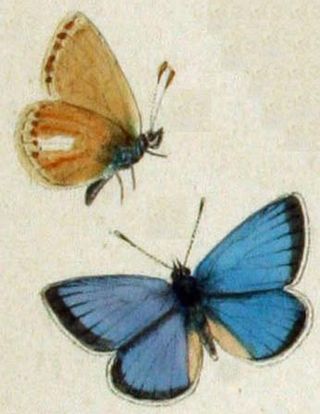
The Übermensch is a concept in the philosophy of Friedrich Nietzsche. In his 1883 book, Thus Spoke Zarathustra, Nietzsche has his character Zarathustra posit the Übermensch as a goal for humanity to set for itself. The Übermensch represents a shift from otherworldly Christian values and manifests the grounded human ideal.

Thus Spoke Zarathustra: A Book for All and None, also translated as Thus Spake Zarathustra, is a work of philosophical fiction written by German philosopher Friedrich Nietzsche; it was published in four volumes between 1883 and 1885. The protagonist is nominally the historical Zoroaster.

The common blue butterfly or European common blue is a butterfly in the family Lycaenidae and subfamily Polyommatinae. The butterfly is found throughout the Palearctic. Butterflies in the Polyommatinae are collectively called blues, from the coloring of the wings. Common blue males usually have wings that are blue above with a black-brown border and a white fringe. The females are usually brown above with a blue dusting and orange spots.

Also sprach Zarathustra, Op. 30 is a tone poem by Richard Strauss, composed in 1896 and inspired by Friedrich Nietzsche's philosophical 1883–1885 novel Thus Spoke Zarathustra. The composer conducted its first performance on 27 November 1896 in Frankfurt. A typical performance lasts half an hour.

The chalkhill blue is a butterfly in the family Lycaenidae. It is a small butterfly that can be found throughout the Palearctic realm, where it occurs primarily in grasslands rich in chalk. Males have a pale blue colour, while females are dark brown. Both have chequered fringes around their wings.

Polyommatus is a genus of butterflies in the family Lycaenidae. Its species are found in the Palearctic realm.

Lichk is a village in the Meghri Municipality of the Syunik Province in Armenia.

Polyommatus damon, the Damon blue, is a butterfly of the family Lycaenidae.

Polyommatus daphnis, the Meleager's blue, is a butterfly of the family Lycaenidae.

Ripart's anomalous blue is a butterfly in the family Lycaenidae.

Polyommatus stoliczkanus is a butterfly in the family Lycaenidae. It is found from the western Himalayas to Nepal.
Polyommatus andronicus is a butterfly in the family Lycaenidae. It is found in north-eastern Greece and south-western Bulgaria, where it inhabits the mountain ranges Slavyanka and southern Pirin.
Polyommatus actinides is a butterfly of the family Lycaenidae. It was described by Otto Staudinger in 1886. It is found in central Asia.

Polyommatus admetus, the anomalous blue, is a butterfly of the family Lycaenidae. It was described by Eugenius Johann Christoph Esper in 1783. It is found in south-eastern Europe and Turkey.

Polyommatus alcestis is a butterfly of the family Lycaenidae. It was described by Hans Zerny in 1932. It is found in Turkey, Iran and the Levant.
Polyommatus arasbarani, the Arasbaran anomalous blue, is a butterfly of the family Lycaenidae. It was described by Carbonell & Naderi in 2000. It is endemic of southern slope of the Meghri Mountains in Armenia and nearby Arasbaran Mountains in northern Iran. Armenia is inhabited by subspecies P. a. neglecta. It inhabits forests alternated with dry steppe-like areas at elevations of 1700–2000 m above sea level. The species is included in the Red Book of Animals of the Republic of Armenia as endangered EN B1a+B2a, although in the book it is still called with the invalid name - Agrodiaetus neglectus.

Polyommatus poseidon is a butterfly of the family Lycaenidae. It was described by Julius Lederer in 1852. It is found from Kütahya in western Turkey to Artvin in north-eastern Turkey, as well as in Georgia.

Arevik National Park, is one of the four protected national parks of Armenia. Occupying an area of 344 km2, it is located in the southern Syunik Province of Armenia.














